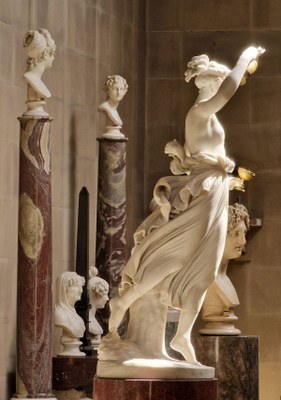Vortrag // Tomas Macsotay: From precious surfaces to outline aesthetics. On the development of atmospheric spaces across the colonial divide
Termindetails
Wann
von 18:15 bis 20:00
Wo
The history of the fit between a piece of figural sculpture and its designed environment has been often addressed in terms of a dissolution of pictorial totalities. A seventeenth-century sense of the wall as a piece of arresting optic orchestration, a great tableau, comes to a close in a new late-eighteenth century phase, characterised by a care for exact and crisp carving and a new interest in silhouette, a flattening effect of pronounced outline and a binary disposition of positive shape against negative foil. The eventual culmination of these developments in the Canovan precious marble objet equals to what Alex Potts, in his Sculptural imagination (2000), described as a new object-bound manner of educating a beholder, who is offered to undertake a series of corridors and itineraries where for protracted visual sensing over the marble´s surfaces. In this presentation I wish to complicate this rather familiar account of baroque-to-neoclassicism progression by introducing some less familiar aspects of an art history of sculpture and ornament, linking deliberately remote locales. Mexican ecclesiastical ornament is seldom given a place in these accounts, and yet some of the most spectacular ensembles of sculpture, ornament and designed wall surfaces are found in Dominican churches in places such as Puebla or Oaxaca. They have the added interest of having produced a number of highly suggestive inaugural sermons (Nicolas Bernardo Ramos de Valderrama, Juan Martinez de la Parra, Juan Antonio de Barbosa) shedding light on the intricate connections between visual spectacle, the love of precious surfaces and the spiritual potential of ornamental schemes that around 1680-1720 become increasingly environmental and totalizing in their nature.
In this presentation I wish to complicate this rather familiar account of baroque-to-neoclassicism progression by introducing some less familiar aspects of an art history of sculpture and ornament, linking deliberately remote locales. Mexican ecclesiastical ornament is seldom given a place in these accounts, and yet some of the most spectacular ensembles of sculpture, ornament and designed wall surfaces are found in Dominican churches in places such as Puebla or Oaxaca. They have the added interest of having produced a number of highly suggestive inaugural sermons (Nicolas Bernardo Ramos de Valderrama, Juan Martinez de la Parra, Juan Antonio de Barbosa) shedding light on the intricate connections between visual spectacle, the love of precious surfaces and the spiritual potential of ornamental schemes that around 1680-1720 become increasingly environmental and totalizing in their nature.
The case of Hispanic colonial churches and their sermons alerts us to the growth of a field of creativity that intrudes in what we usually regard as opposite aesthetics of the baroque and the neoclassical. Ornament and design in the eighteenth century were in fact incrementally complemented by new attention for the manipulation of natural light and the mastery of artificial light as themselves capable of “producing” captivating imagery. An increasing use of devices both architectural (cupolas, lanterns, hidden windows, “transparentes”) and ephemeral (illuminations and transparencies, mirrors and night-time illumination technology optic boxes and magic lanterns) were meant to complement the visual arrangements in such ways as to allow for rare visual qualities and transformations to take shape before the eyes of marvelled and curious beholders. In this contribution I will suggest how light and its concomitant sensibility for atmosphere and affect may offer an account of the rationale that eventually transformed the preciousness of baroque surface into the unearthly flat screens of neoclassical outline.
[Caption: Antonio Canova, Hebe, Marble and copper, 1808, Chatsworth, Derbyshire, UK]
___________
TEILNAHME:
Die Veranstaltung wird parallel via Zoom übertragen. Dem Zoom-Meeting können Sie unter folgendem Link beitreten: https://us02web.zoom.us/j/85659345839?pwd=UmFZYU0xN1NxMGJ1MjlQM054NXgvZz09. Meeting-ID: 856 5934 5839 | Passwort: 148258.
